elwray
Active Member
Hello all, hoping you can give me some input here ...
I built an arbor to grow my hops on over the gate to the swimming pool. I know it's probably not the most optimal setup for hop yield, and I don't prune very many bines, but it's more for decoration than brewing purposes - the hop harvest is just an added bonus!
Anyway, surrounding the pool fence we have arborvitaes, an evergreen tree/shrub. Last summer noticed an infestation of Bag Worms in one section of the arborvitaes, and sprayed Sevin liberally in the area.
It seemed to work pretty decently, but they are back again this year. Since we were on the look out for them, we're catching them much earlier. The bagworms seem to be tasting my hops as well.... I've already sprayed Sevin on the arborvitaes, however I don't want to spray that on my hops since I have a considerable amount of flowers and cones already.
I've read that a good control is BT (Bacillus thuringiensis) which is a bacterial toxin for caterpillar control. This toxin is reportedly not harmful to humans or pets (unless I suppose you're raising pet caterpillars ) and the toxin is broken down naturally in 3-5 days in the sun.
) and the toxin is broken down naturally in 3-5 days in the sun.
It looks to be a "garden safe" pesticide, however I just wanted to know what you all's take on it is.
For this season, since the bag worms have already made their bags and thus much less susceptible to pesticide ingestion/absorption, I'll probably just keep an eye on the hops and manually pick off the bag worms and throw them into the chiminea.
Then come early spring 2011, I will BT/Sevin the area before the bagworms have made their silk bags and are much more susceptible to the pesticides!
***CENTRAL NJ - Keep an eye out for these bag worms. We never ever had anything like this before, and didn't notice them until July 4th, 2009. By the time I sprayed the arborvitaes in mid July, significant damage was done, and the eggs were laid. In their first season, these pests killed a ~10 year old arborvitae and significantly impacted at least two others.
http://woodypests.cas.psu.edu/factsheets/insectfactsheets/html/bagworm.html
http://www.mylawnadvice.com/images/SpruceBagworms.jpg
http://www.lifeandlawns.com/tag/bag-worms/
http://www.nfs.unl.edu/foresthealth/bagwormimage.asp
***
Anyways, I'm not -too- worried about them this year since they don't seem to enjoy the hop leaves. Here are some pics of my pool-hops.
Second year centennials, rhizomes from freshops.com
One rhizome at the base of each side of the arbor.
Early spring, fertilized with chicken **** when cleaning out the coop.
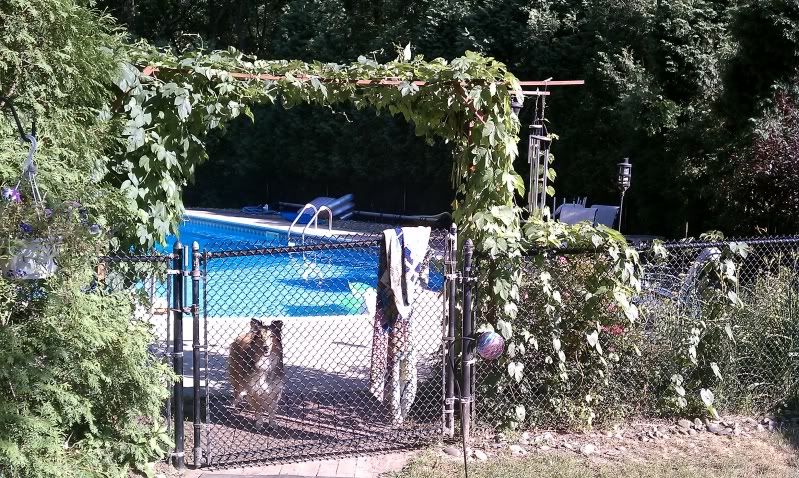
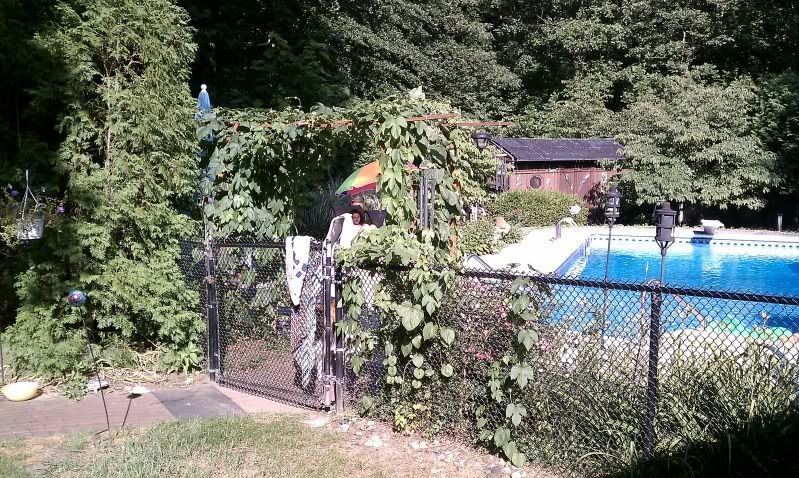
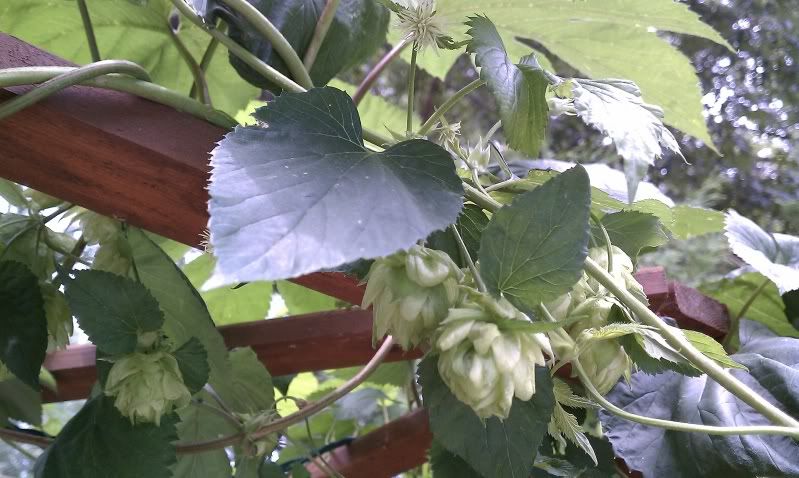
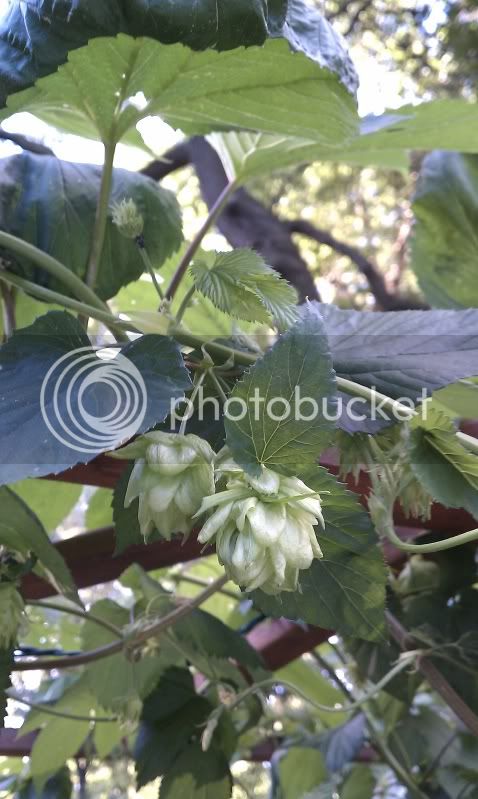
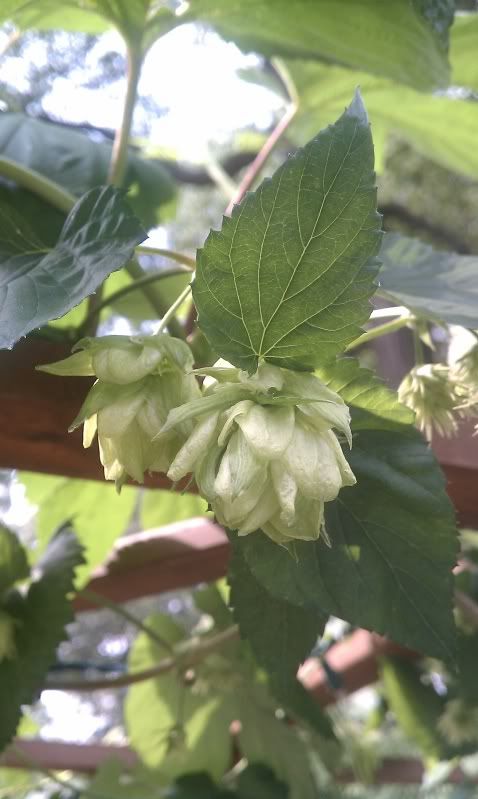
I built an arbor to grow my hops on over the gate to the swimming pool. I know it's probably not the most optimal setup for hop yield, and I don't prune very many bines, but it's more for decoration than brewing purposes - the hop harvest is just an added bonus!
Anyway, surrounding the pool fence we have arborvitaes, an evergreen tree/shrub. Last summer noticed an infestation of Bag Worms in one section of the arborvitaes, and sprayed Sevin liberally in the area.
It seemed to work pretty decently, but they are back again this year. Since we were on the look out for them, we're catching them much earlier. The bagworms seem to be tasting my hops as well.... I've already sprayed Sevin on the arborvitaes, however I don't want to spray that on my hops since I have a considerable amount of flowers and cones already.
I've read that a good control is BT (Bacillus thuringiensis) which is a bacterial toxin for caterpillar control. This toxin is reportedly not harmful to humans or pets (unless I suppose you're raising pet caterpillars
It looks to be a "garden safe" pesticide, however I just wanted to know what you all's take on it is.
For this season, since the bag worms have already made their bags and thus much less susceptible to pesticide ingestion/absorption, I'll probably just keep an eye on the hops and manually pick off the bag worms and throw them into the chiminea.
Then come early spring 2011, I will BT/Sevin the area before the bagworms have made their silk bags and are much more susceptible to the pesticides!
***CENTRAL NJ - Keep an eye out for these bag worms. We never ever had anything like this before, and didn't notice them until July 4th, 2009. By the time I sprayed the arborvitaes in mid July, significant damage was done, and the eggs were laid. In their first season, these pests killed a ~10 year old arborvitae and significantly impacted at least two others.
http://woodypests.cas.psu.edu/factsheets/insectfactsheets/html/bagworm.html
http://www.mylawnadvice.com/images/SpruceBagworms.jpg
http://www.lifeandlawns.com/tag/bag-worms/
http://www.nfs.unl.edu/foresthealth/bagwormimage.asp
***
Anyways, I'm not -too- worried about them this year since they don't seem to enjoy the hop leaves. Here are some pics of my pool-hops.
Second year centennials, rhizomes from freshops.com
One rhizome at the base of each side of the arbor.
Early spring, fertilized with chicken **** when cleaning out the coop.







